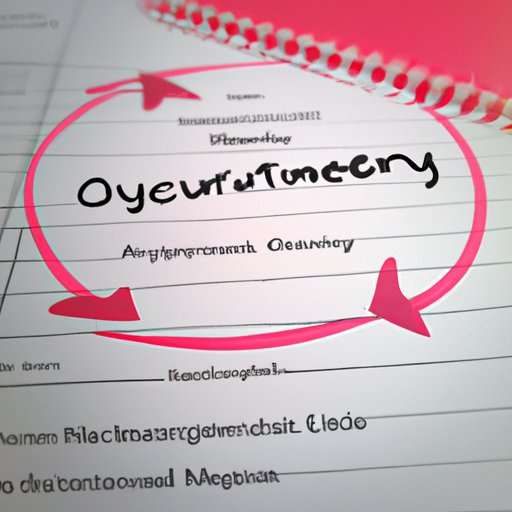
Introduction
Have you ever wondered when you are most likely to conceive? It all comes down to understanding ovulation timing. Knowing when you ovulate is crucial for women who are trying to conceive, and can even be helpful for those who want to avoid pregnancy. In this article, we will explore the science behind menstrual cycles, tracking methods to determine ovulation, the link between hormones and ovulation, and debunking fertility myths.
The Science Behind Menstrual Cycles: Understanding Ovulation and Fertility
A menstrual cycle is the monthly cycle that a woman’s body goes through to prepare for pregnancy. The menstrual cycle is divided into four phases: menstruation, the follicular phase, ovulation, and the luteal phase.
The main hormones that regulate the menstrual cycle are estrogen and progesterone. Estrogen is responsible for thickening the uterine lining in preparation for pregnancy, while progesterone maintains a healthy environment for a fertilized egg to implant.
Ovulation is the release of an egg from the ovaries and occurs around day 14 of a 28-day menstrual cycle. This is when a woman is most fertile and has the highest chance of conceiving. Understanding ovulation timing is crucial for women who want to conceive.
Tracking Your Menstrual Cycle: A Guide to Understanding Ovulation
Tracking your menstrual cycle is the key to understanding ovulation timing. Some methods include basal body temperature charting, cervical mucus monitoring, and ovulation predictor kits.
Basal body temperature charting involves taking your temperature every morning at the same time before getting out of bed. This method helps you determine when you ovulate by tracking the slight increase in temperature that occurs after ovulation. Cervical mucus monitoring involves determining the texture and consistency of your cervical mucus to determine when you are most fertile. An ovulation predictor kit is a urine test that detects luteinizing hormone (LH), which surges just before ovulation.
Each tracking method has pros and cons. Basal body temperature charting requires daily tracking and consistency. Cervical mucus monitoring can be difficult, and may require practice to master. Ovulation predictor kits can be expensive and may produce false readings.
The Link Between Hormones and Ovulation: What You Need to Know
Hormones play a major role in ovulation and the menstrual cycle. The follicular phase, which occurs in the first half of the menstrual cycle, is when the follicles in the ovaries grow and develop. This phase is regulated by estrogen.
The luteal phase, which occurs in the second half of the menstrual cycle, is regulated by progesterone. After ovulation occurs, the corpus luteum forms in the ovary and begins producing progesterone.
Factors such as stress or illness can impact ovulatory timing. Stress can delay ovulation, while illness can cause an early or delayed ovulation. Therefore, it’s best to maintain a healthy lifestyle to optimize your chances of conception.
When Should You Expect to Ovulate After Your Period?
The variability of menstrual cycles and ovulatory timing makes determining when you will ovulate challenging. While the average timing of ovulation occurs around day 14 of a 28-day menstrual cycle, not all women have regular cycles. In fact, some women may have cycles that last anywhere from 21 to 35 days.
Factors that may influence ovulatory timing include age, overall health, and use of hormonal contraception. Women who are older may experience an earlier or later ovulation than they did in their younger years. Overall health and lifestyle choices, such as smoking or drinking, can also impact ovulatory timing.
Not understanding ovulatory timing can lead to unintended pregnancy or difficulty conceiving. Therefore, tracking methods and education are important for your overall reproductive health and wellbeing.
Fertility Myths: Debunking the 14-Day Rule
The 14-day rule is a common myth that claims that ovulation occurs 14 days after the start of your period. However, this is not true for all women. In fact, some women may ovulate as early as day 10 or as late as day 20 of their menstrual cycle.
It’s important to note that every woman’s body is different. Individualized tracking and understanding of one’s own cycle is essential to predicting ovulatory timing accurately.
Optimizing Your Chances of Conception: Using Ovulation Timing to Your Advantage
Using ovulation timing to your advantage is crucial for women who want to conceive. Timing intercourse during ovulation is one of the most important factors for success. You should aim to have intercourse two to three days before and on the day of ovulation.
Other factors that can impact fertility include age, overall health, and lifestyle choices. Women who are older may experience decreased fertility, and smoking or excessive alcohol consumption can negatively impact fertility. Maintaining a healthy lifestyle, including a balanced diet and regular exercise, can optimize your chances of conception.
Conclusion
Understanding ovulation timing is essential for women who want to conceive or avoid pregnancy. Tracking methods such as basal body temperature charting, cervical mucus monitoring, and ovulation predictor kits can help determine ovulatory timing. It’s important to note that every woman’s body is different and individualized tracking is essential. By optimizing your chances of conception, you can increase your overall reproductive health and wellbeing.




